Discover 20 Famous Paintings All Located at Paris’ Iconic Louvre Museum
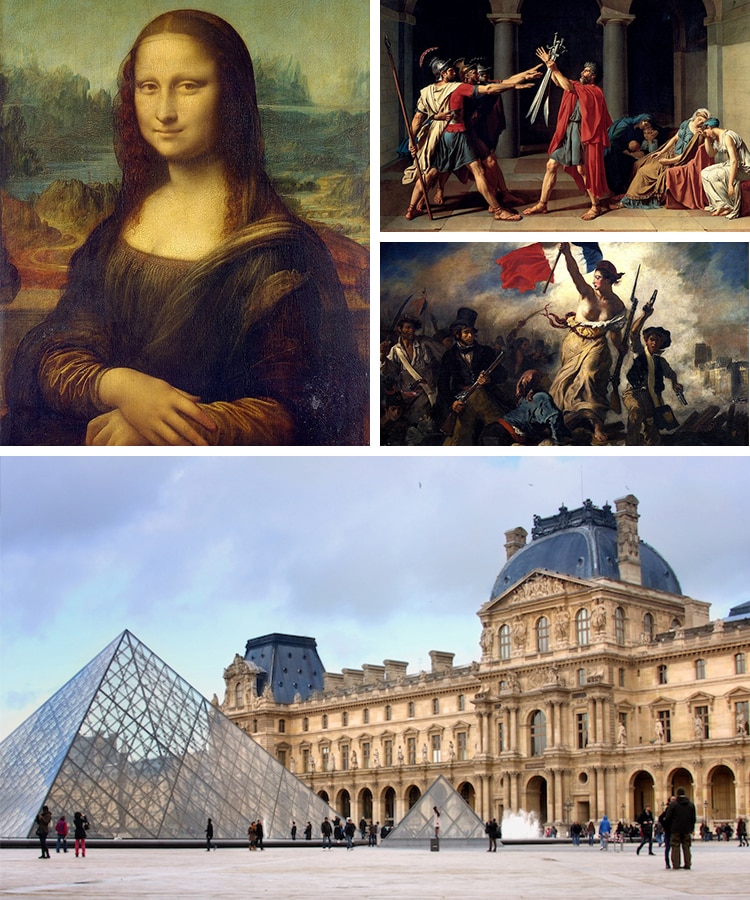
Paris is one of the ultimate destinations for art and architecture lovers. With an array of world-class museums, it's no wonder thousands of tourists pour into the City of Light each year. And while there are many worth seeing, the Louvre remains the most visited art museum in the world.
Housed in this historic palace are over 7,500 paintings. While some of these are more well-known masterpieces, like Leonardo da Vinci's Mona Lisa and Delacroix's Liberty Leading the People, others may not be as recognizable to a casual fan.
Here, we explore some of the most famous paintings that you can see in the Louvre Museum today.
What is the Louvre?
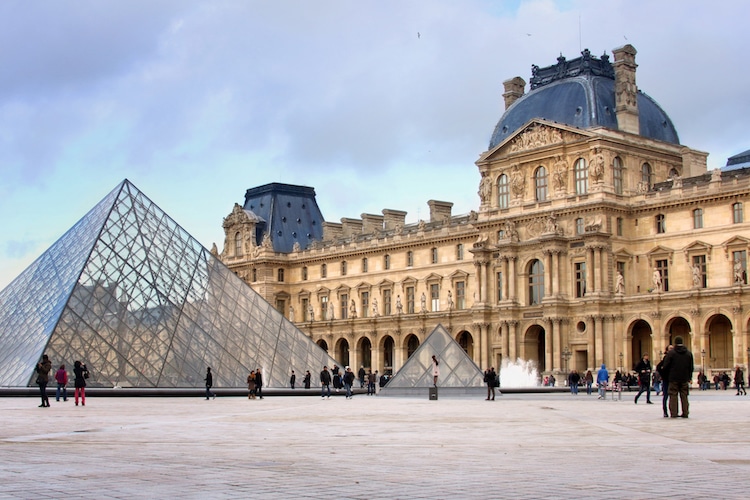
Photo of the Louvre Museum, Paris (Photo: outline205/DepositPhotos)
The Louvre Museum, or the Musée du Louvre, is the most visited museum in the world, and home to some of the most famous sculptures and paintings. Located in Paris, France, the historic art institution has existed for about 800 years.
Its origins begin in the 12th century when King Philippe Auguste wanted to fortify Paris with a wrap-around wall. However, due to the Seine river, the border was left partially open. To compensate for this weakness, a castle was built by the wall. Later, in the 13th century, the castle was expanded, becoming less of a fortress and more of a palace.
Over time, as Paris grew beyond its borders, the structure was repurposed as a hideout for French royalty. Then, in 1528, King François I declared the Louvre his residence, requiring extensive renovations on the grounds. Hundreds of years passed and the palace experienced more construction under the reign of King Louis XIII—who added wings—and Louis IV (the famous “Sun King”)—who added numerous galleries. Afterward, the galleries were used to house the king's art collection. Starting in 1684, visitors were allowed to visit them when the king was not living at the Louvre, which is the start of its museum history.
After functioning as a private museum for several decades, the French Revolution triggered the transformation of the palace into a public museum, officially opening on August 10, 1793.
How many paintings are in the Louvre?
The Louvre contains over 7,500 paintings, many of which are by French artists. The expansive collection features art dating from the 13th century all the way to the mid-19th century, encompassing several different art movements and styles. Additionally, most of the Italian paintings, such as the world-renowned Mona Lisa, located in the Louvre were acquired by Francis I and Louis XIV.
Famous Paintings in the Louvre
Giotto, St. Francis of Assisi Receiving the Stigmata, c. 1295–1300

Giotto, “St. Francis of Assisi Receiving the Stigmata,” c. 1295–1300 (Photo: Wikimedia Commons, Public domain)
At a time when the Byzantine style of flat, stylized compositions dominated Italy, Proto-Renaissance artist Giotto based his art on life. His naturalistic paintings set the foundation for successors like Botticelli and Michelangelo. His painting Saint Francis Receiving the Stigmata was originally intended for the Church of Saint Francis in Pisa, depicting a scene from the life of Saint Francis, in which he receives the stigmata from Christ in the form of an angel.
Raphael, St. Michael Overwhelming the Demon, 1518
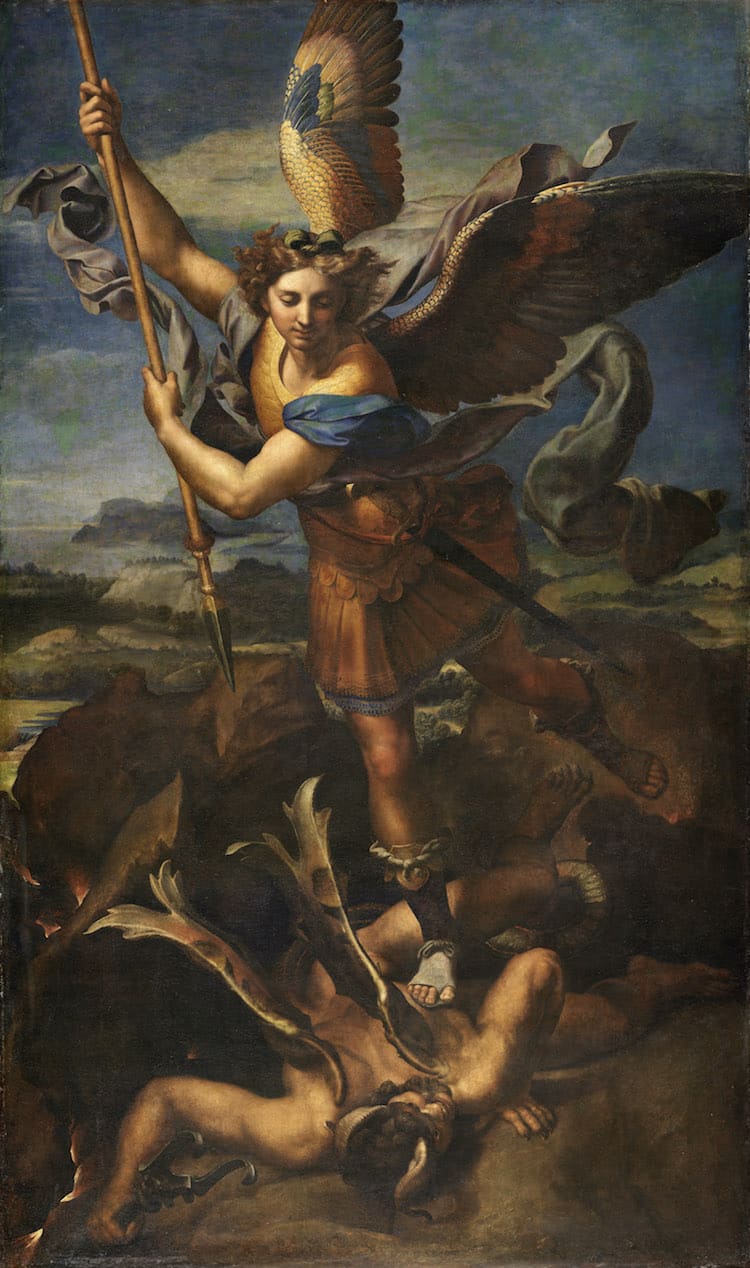
Raphael, “Saint Michael Vanquishing Satan,” 1518 (Photo: Wikimedia Commons, Public domain)
Raphael was one of the most influential figures of the Italian Renaissance. Despite only living to 37 years of age, he left behind an influential body of work. His painting Saint Michael Vanquishing Satan was made two years prior to his death, depicting the archangel Michael subduing Satan with his lance. It symbolizes the triumph of good over evil.
Leonardo da Vinci, The Virgin on the Rocks, c. 1483–1486
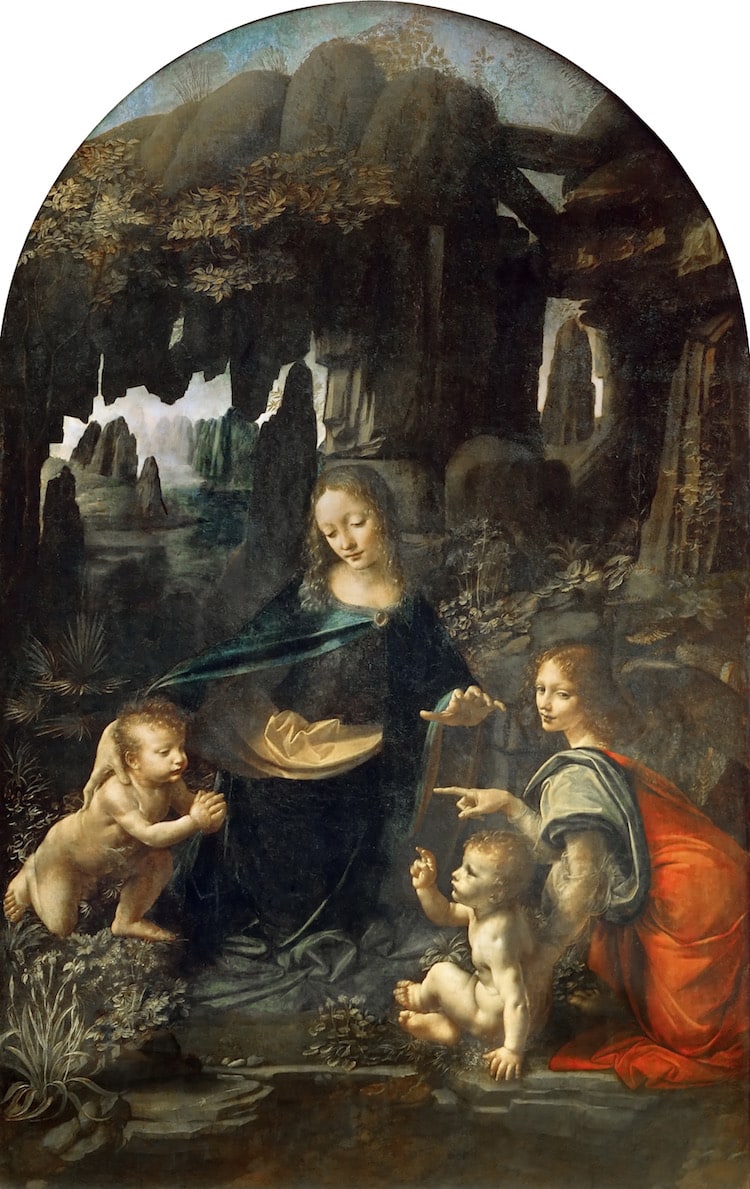
Leonardo da Vinci, “Virgin of the Rocks,” c. 1483–1486 (Photo: Louvre via Wikimedia Commons, Public domain)
Together with Michelangelo and Raphael, Leonardo da Vinci is considered one of the pillars of the Italian Renaissance. He created two versions of the Virgin of the Rocks during his lifetime, but the first version—which is more highly regarded by historians—hangs in the Louvre. It features a softly colored depiction of the Virgin Mary and angel Uriel overseeing the baby Jesus and toddler John the Baptist, set against a rocky green landscape rendered in sfumato.
Leonardo da Vinci, The Virgin and Child with Saint Anne, c. 1501–1519
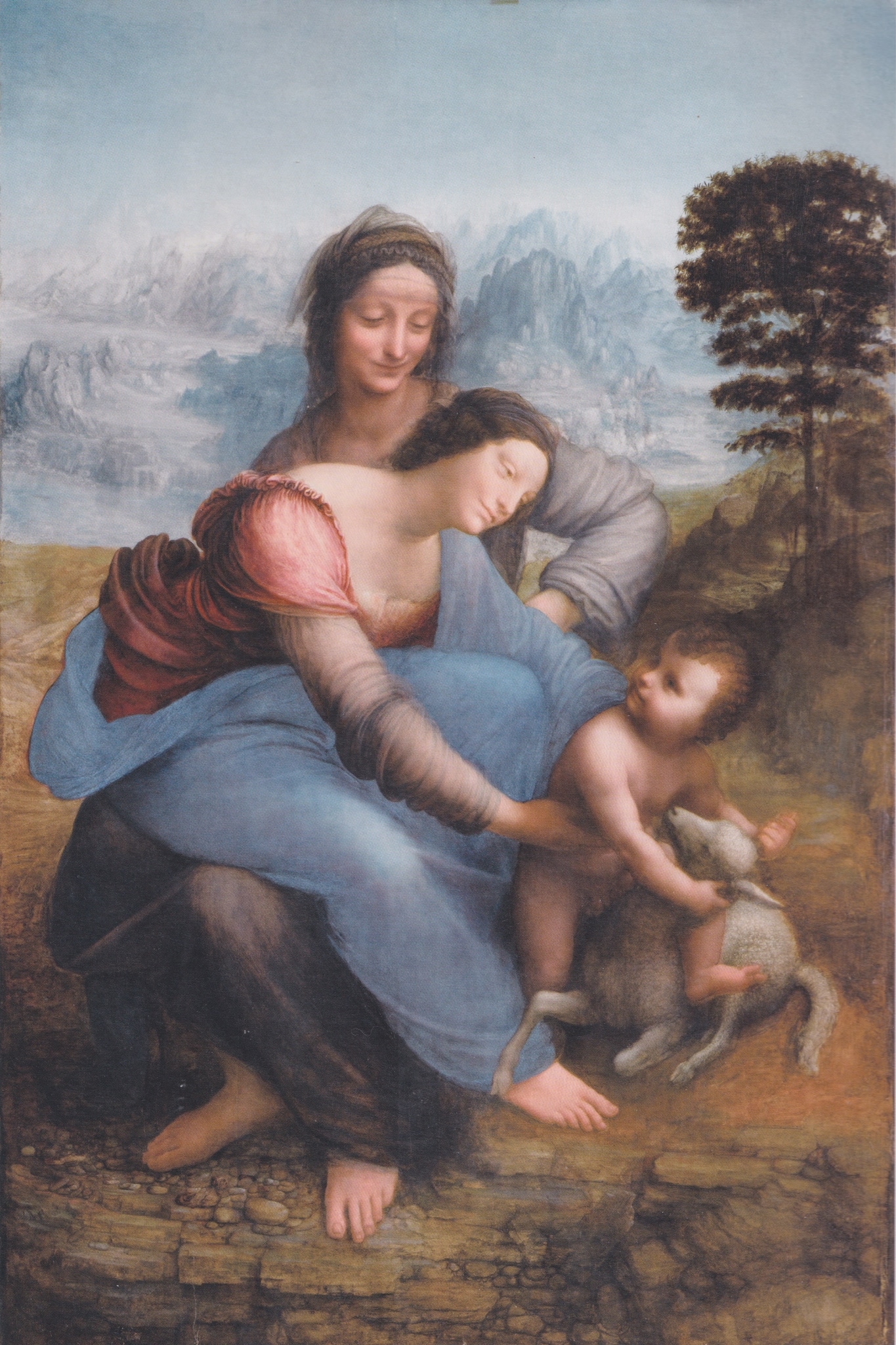
Leonardo da Vinci, “The Virgin and Child with Saint Anne,” c. 1501–1519 (Photo: Wikimedia Commons, Public domain)
Although it was left unfinished, The Virgin and Child with Saint Anne is a significant painting by Da Vinci, primarily due to its mystery. Using his recognizable hazy painting style, he depicts Mary sitting across Saint Anne's lap, while a baby Jesus plays with a lamb. The strange composition continues to puzzle art historians, as it is an atypical representation of Mary and Saint Anne. Additionally, due to the perspective, it appears as though Saint Anne is portrayed to be much larger than Mary. While it was commissioned by Francis I as a celebration of his daughter's birth, Da Vinci never completed it for reasons unknown.
Leonardo da Vinci, The Mona Lisa, c. 1503–1506
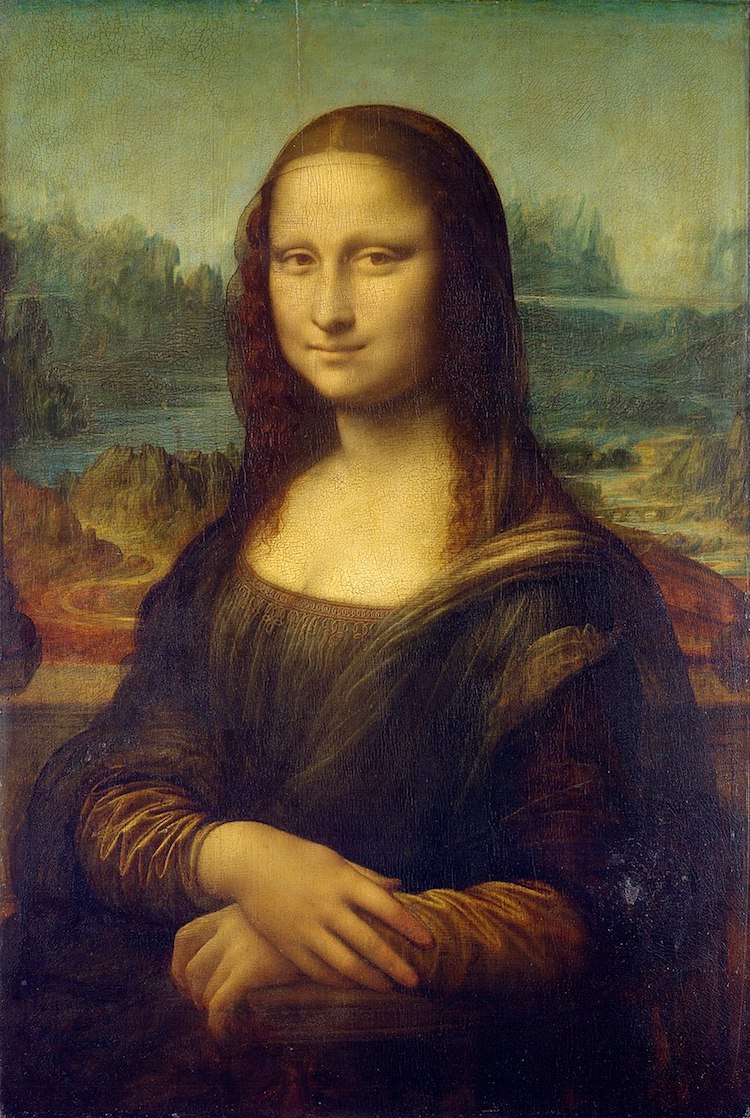
Leonardo da Vinci, “The Mona Lisa,” c. 1503–6 (Photo: Louvre via Wikimedia Commons, Public domain)
Renowned for both its curious iconography and its unique history, Leonardo da Vinci's Mona Lisa has become one of the most famous paintings in art history. The Renaissance portrait features a female figure—believed by most to be Lisa Gherardini, the wife of cloth and silk merchant Francesco Giocondo—from the waist up. She is shown seated in a loggia, or a room with at least one open side.
Behind her is a hazy and seemingly isolated landscape imagined by the artist and painted using sfumato, a technique resulting in forms “without lines or borders, in the manner of smoke or beyond the focus plane.”
Andrea Mantegna, Minerva Expelling the Vices From the Garden of Virtue, 1502
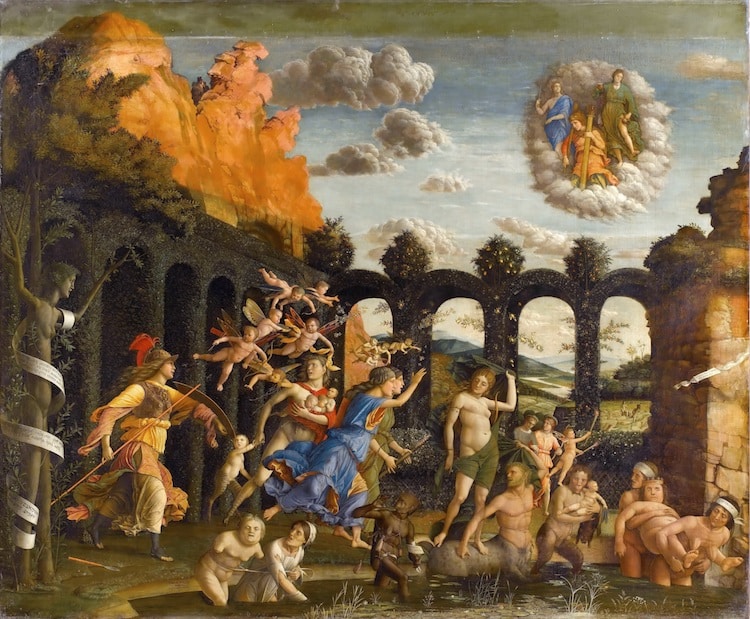
Andrea Mantegna, “Minerva Expelling the Vices from the Garden of Virtue,” 1502 (Photo: Wikimedia Commons, Public domain)
A pioneer of the Italian Renaissance, Andrea Mantegna created a diverse body of work that explored perspective. His painting Minerva Expelling the Vices From the Garden of Virtue was completed for Isabella d'Este and portrays the Roman goddess Minerva rescuing Diana, the goddess of chastity, from a centaur.
Pietro Perugino, The Battle Between Love and Chastity, 1503
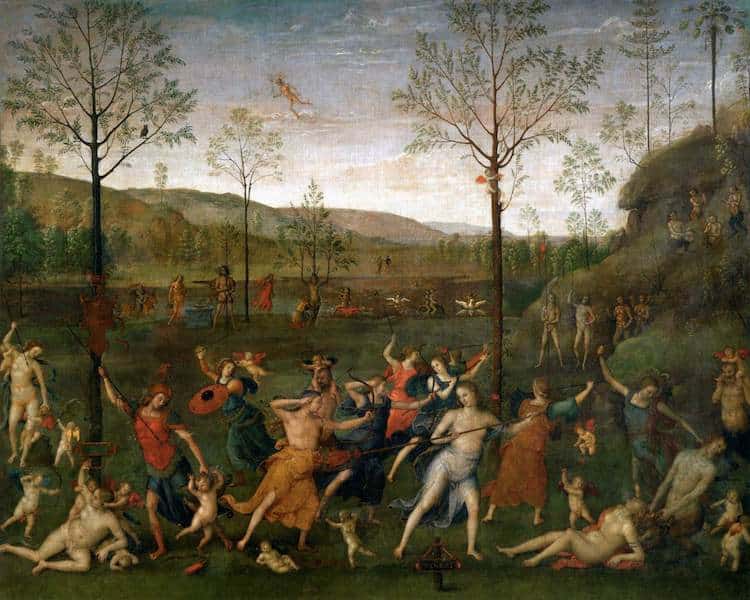
Pietro Perugino, “Combat of Love and Chastity,” 1503 (Photo: Wikimedia Commons, Public domain)
Renaissance artist Pietro Perugino is best known for his role as Raphael's tutor. However, he also left behind a portfolio of masterpieces. His painting The Battle Between Love and Chastity was completed for the Marchesa of Mantua, Isabella d'Este. It depicts a struggle between the symbolic figures of Love and Chastity in tempera.
Titian (Attributed), The Pastoral Concert, 1509
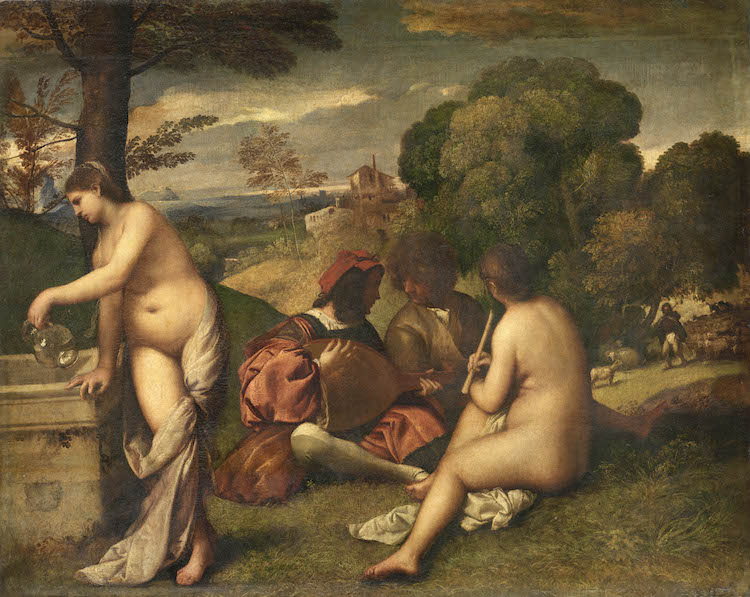
Attributed to Titian and/or Giorgione, “The Pastoral Concert,” 1509 (Photo: Wikimedia Commons, Public domain)
During the Renaissance, both the Venetian School and the Florentine School sought the best way to emulate nature in their art. However, while the Florentine School believed in the enlightened powers of drawing, the Venetian School focused on color and its emotional qualities. The Pastoral Concert embodies the values of this style, depicting a gathering of four figures in a picturesque setting with vivid naturalism. While originally attributed to Giorgione, art historians believe this painting is more likely an early work by his contemporary Titian, who was known for his portrayals of voluptuous women.
Veronese, The Wedding at Cana, 1563
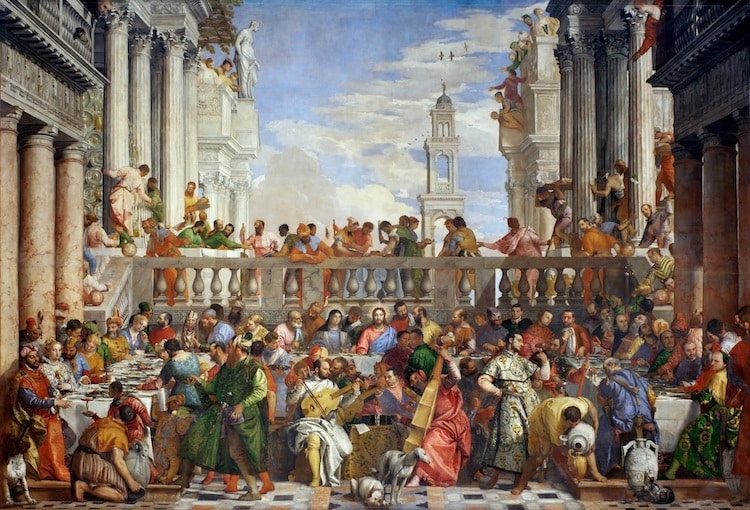
Veronese, “The Wedding at Cana,” 1563 (Photo: Wikimedia Commons, Public domain)
Towards the end of the Renaissance, a new style emerged called Mannerism. It put a stylized twist on classicism by elongating figures and placing them in intentionally perfect arrangements. This interest in unnatural symmetry can be seen in The Wedding Feast at Cana. Made by artist Paolo Veronese in 1563, it is a large-scale painting with dozens of figures packed inside the composition. It was brought to the Louvre after the French Revolutionary Wars in the 18th century.
Caravaggio, Death of the Virgin, c. 1604–1606
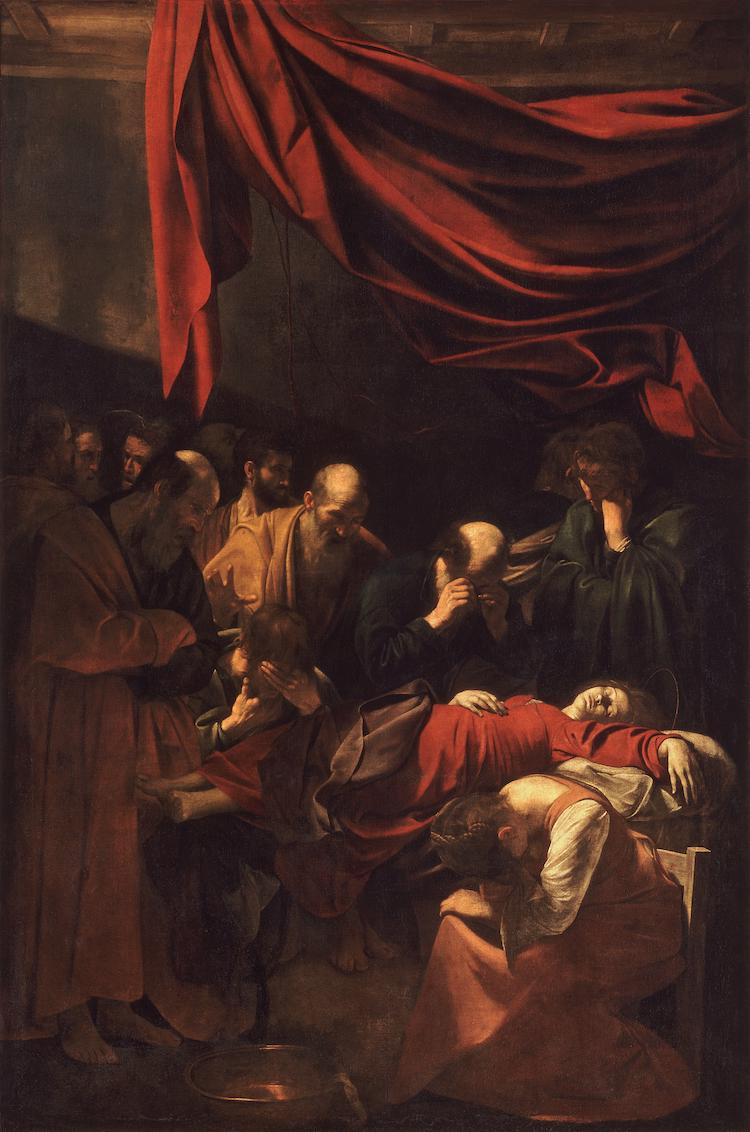
Caravaggio, “Death of the Virgin,” c. 1604–1606 (Photo: Wikimedia Commons, Public domain)
The Baroque period was an art movement defined by an interest in dramatic, awe-inspiring work. One of the artists responsible for creating the key features of this style is the Italian painter Caravaggio. His work, Death of the Virgin, represents many key characteristics of his dramatic style, including strong contrast of light and dark, a single light source, everyday people as models, and a depiction of a single moment in time. However, due to the unconventional depiction of the Virgin Mary, the painting was rejected by the commissioner.
Georges de la Tour, The Card Sharp With the Ace of Diamonds, c. 1634
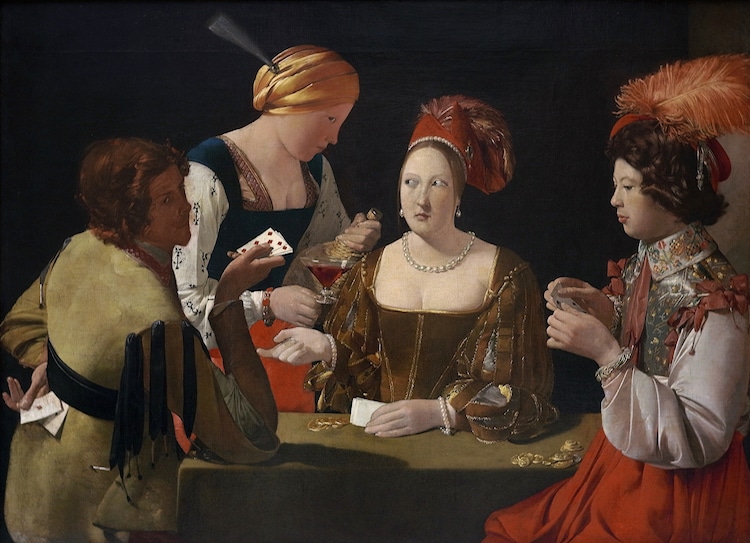
Georges de La Tour, “The Card Sharp with the Ace of Diamonds,” c. 1635 (Photo: Wikimedia Commons, CC BY-SA 4.0)
Baroque artist Georges de La Tour was known for his chiaroscuro paintings with smooth doll-like figures. His painting The Card Sharp with the Ace of Diamonds depicts a card game set against a pitch-black background in which a young man is retrieving an ace of diamonds from behind his back, with hopes to win the game.
Nicolas Poussin, The Rape of the Sabine Women, 1637–1638
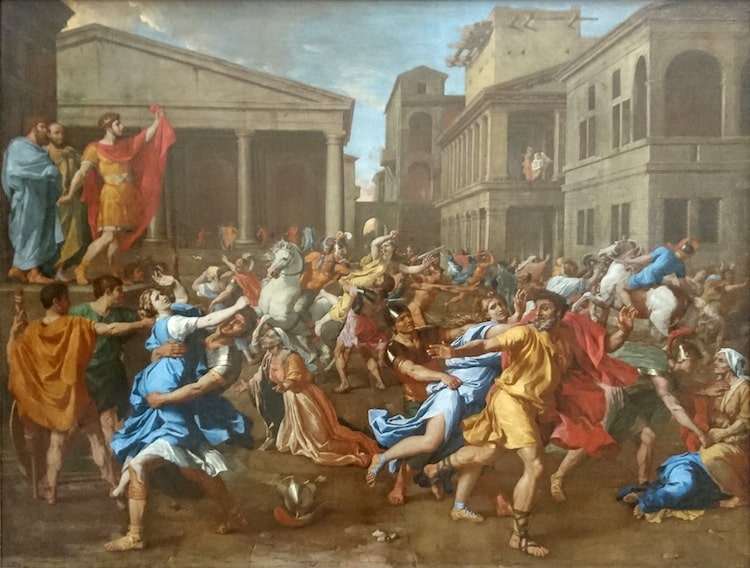
Nicolas Poussin, “The Abduction of the Sabine Women,” 1637–1638 (Photo: Louvre via Wikimedia Commons, Public domain)
French artist Nicolas Poussin cultivated a Baroque style based on bright colors, clarity, and line. He conveyed drama in his paintings by organizing numerous figures in active poses, as seen in his piece, The Abduction of the Sabine Women. Here, the chaotic scene is created by the dozens of running, jumping, and twisting figures obstructing the large open space.
Johannes Vermeer, The Lacemaker, c. 1669–1671
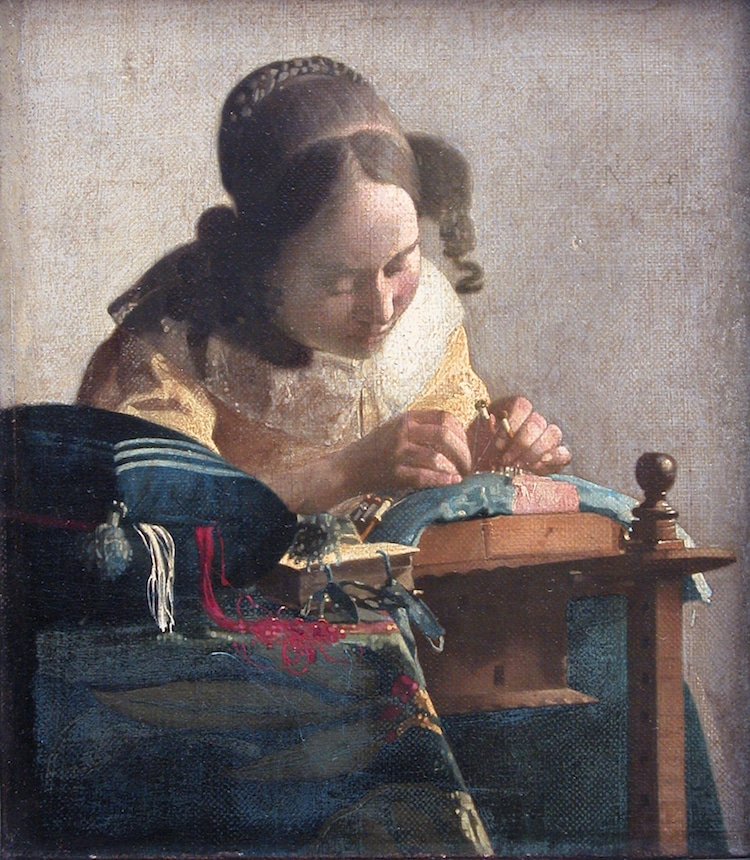
Johannes Vermeer, “The Lacemaker,” c. 1669–1671 (Photo: Wikimedia Commons, Public domain)
In the 17th century, the Netherlands experienced a period of artistic prosperity known as the Dutch Golden Age. One of the artists that emerged from this period was Johannes Vermeer. Best known for his masterpiece The Girl with a Pearl Earring, he created relatively small paintings with meticulous attention to detail, light, and color. The Lacemaker is his smallest known work, which depicts a young woman in a yellow dress carefully making bobbin lace. He very likely used a camera obscura— a popular artist's device—to help him execute the composition of the piece.
Hyacinthe Rigaud, Portrait of Louis XIV, c. 1700–1701
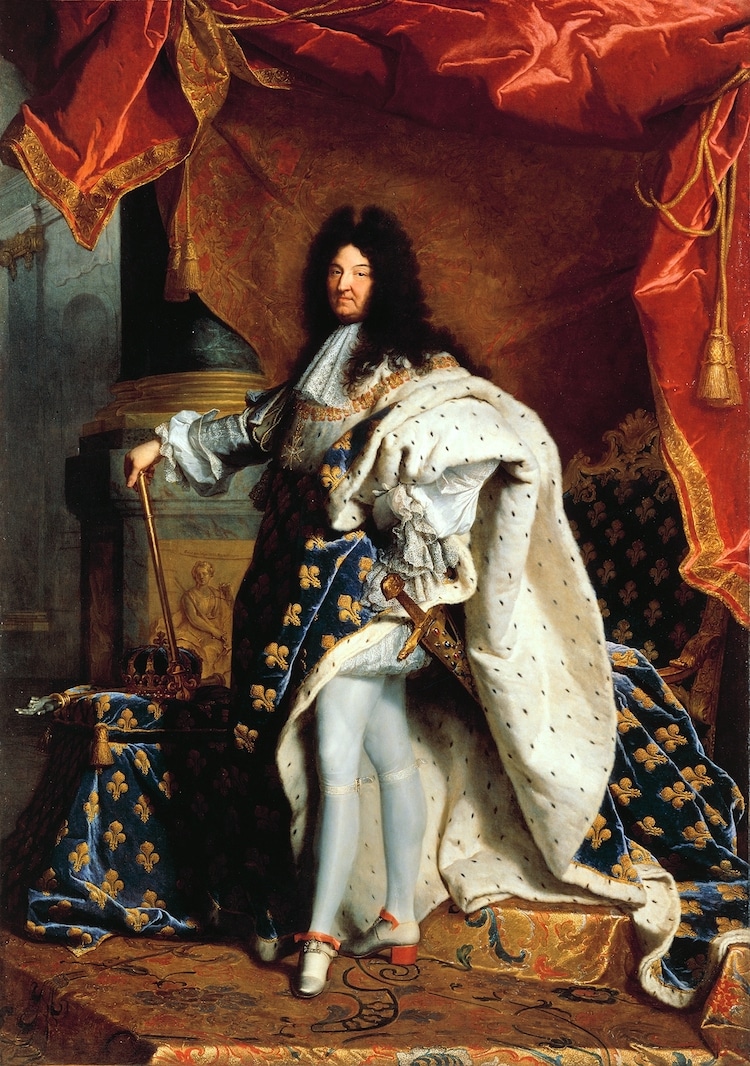
Hyacinthe Rigaud, “Portrait of Louis XIV,” c. 1700–1701 (Photo: Wikimedia Commons, Public domain)
Louis XIV ruled France for over 72 years, the longest reign of any monarch of a sovereign nation. During that time he oversaw the construction of one of the gems of France: the Palace of Versailles. Hyacinthe Rigaud immortalized the Sun King's likeness in the Portrait of Louis XIV. Originally intended for his grandson, the painting became the official portrait of Louis XIV and his best-known depiction.
Jacques-Louis David, Oath of the Horatii, 1784
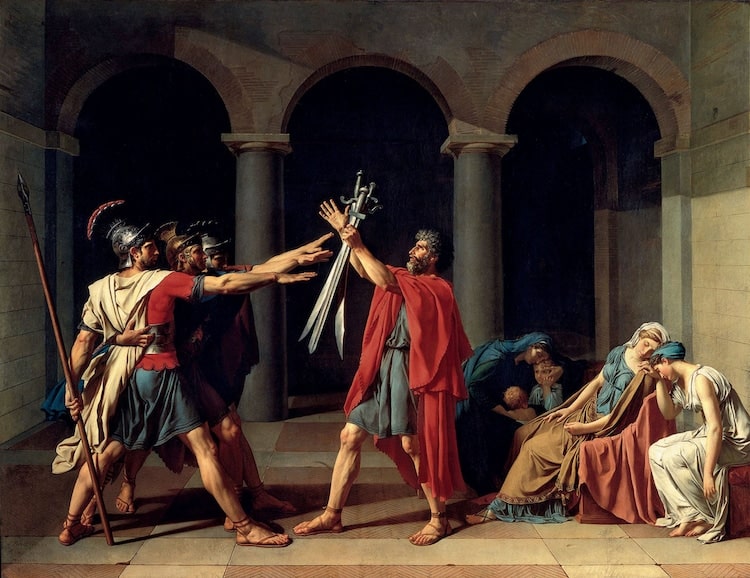
Jacques-Louis David, “The Oath of the Horatii,” 1784 (Photo: Wikimedia Commons, Public domain)
Established in the mid-1700s, the Neoclassical movement is defined by an interest in classical (i.e. Roman and Ancient Greece) aesthetics, principles, and subject matter. The art of French painter Jacques Louis David—the leader of the style—represents the characteristics of Neoclassical painting. His work, The Oath of the Horatii embodies these traits in the depiction of a Roman legend, the austere color palette, and harmonious composition.
Jacques-Louis David, The Coronation of Napoleon, 1805–1807
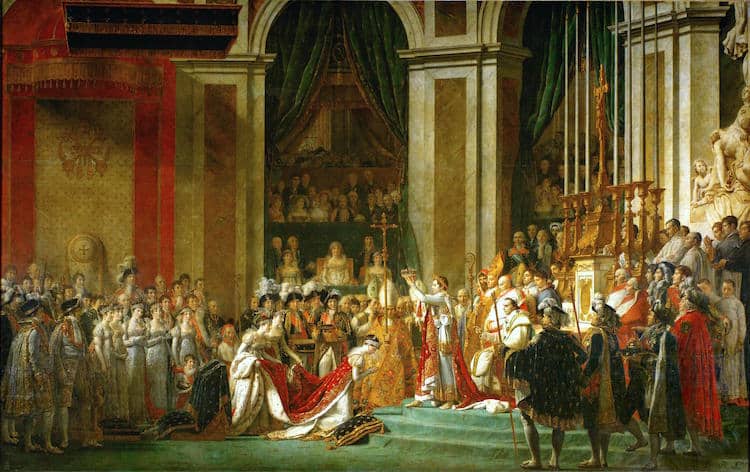
Jacques-Louis David, “The Coronation of Napoleon,” 1805–1807 (Photo: Wikimedia Commons, Public domain)
About 2o years after he produced The Oath of the Horatii, David was the official painter of Napoleon and was commissioned to paint his coronation. The Coronation of Napoleon is a Neoclassical-style painting depicting the French leader—dressed in robes similar to Roman emperors—crowning himself before a large gathering. Included in the group of spectators are portraits of his wife Joséphine, his sisters, and even David, himself.
Théodore Géricault, The Raft of Medusa, 1818–1819
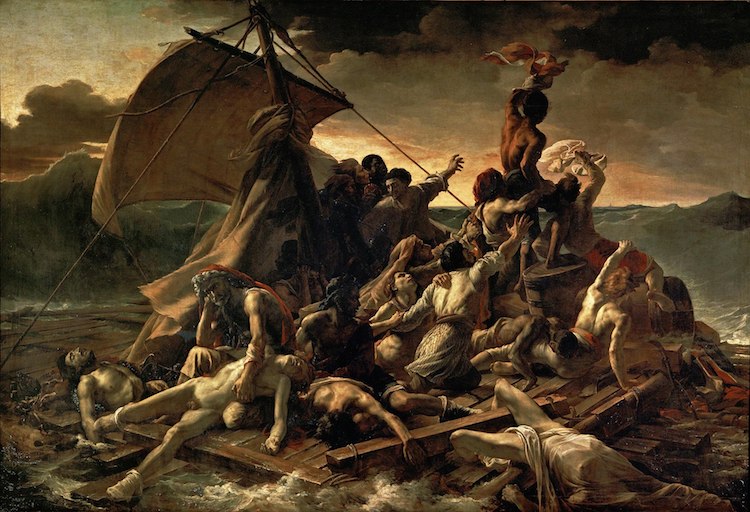
Théodore Géricault, “The Raft of The Medusa,” 1818–9 (Photo: Louvre via Wikimedia Commons, Public domain)
The Romantic art movement emphasized emotion, the sublimity of nature, and the individual. Théodore Géricault's The Raft of The Medusa depicts a historical shipwreck off the coast of modern-day Mauritania, where sailors survived treacherous conditions to find a safe haven. The painting's use of scale and drama makes it a cornerstone of French Romanticism.
Eugène Delacroix, Dante and Virgil in Hell, 1822
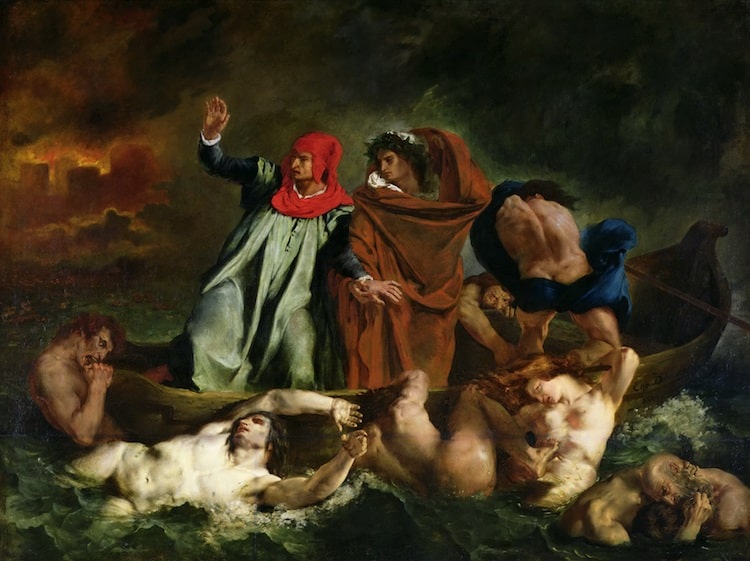
Delacroix, “Dante and Virgill in Hell,” 1822 (Photo: Wikimedia Commons, Public domain)
A master of color, movement, and drama, Eugène Delacroix was a leader of the Romanticism art movement and an influential figure in the work of the Impressionists. His oeuvre spanned contemporary events, mythological scenes, Orientalism, and portraiture. Dante and Virgil in Hell was his first great painting, depicting the author Dante surrounded by scenes from his epic poem, Inferno. Here, Delacroix's style is clearly departing from Neoclassical ideals, becoming closer to the expressive qualities of Romanticism he would become known for.
Eugène Delacroix, Liberty Leading the People, 1830
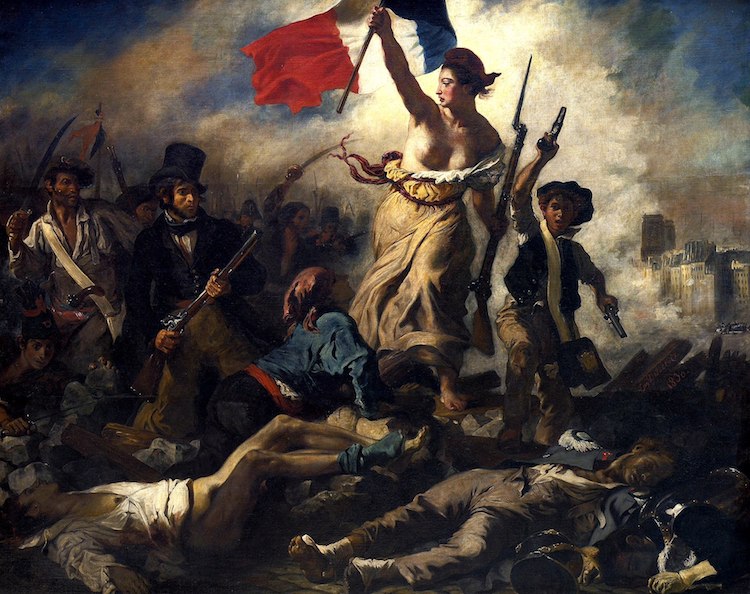
Eugène Delacroix, “Liberty Leading the People,” 1830 (Photo: Louvre via Wikimedia Commons, Public domain)
In the fall of 1830, Delacroix completed what would become his most famous and admired painting entitled Liberty Leading the People. Set on the streets of Paris (Notre-Dame Cathedral can be seen in the smoke-filled background) and full of symbolism, the large-scale painting shows Parisians following a female figure carrying the French flag. This allegorical character is commonly believed to be an early version of Marianne, a personification of the French Republic, and intended to embody the concept of liberty.
Jean-August-Dominique Ingres, The Turkish Bath, 1862
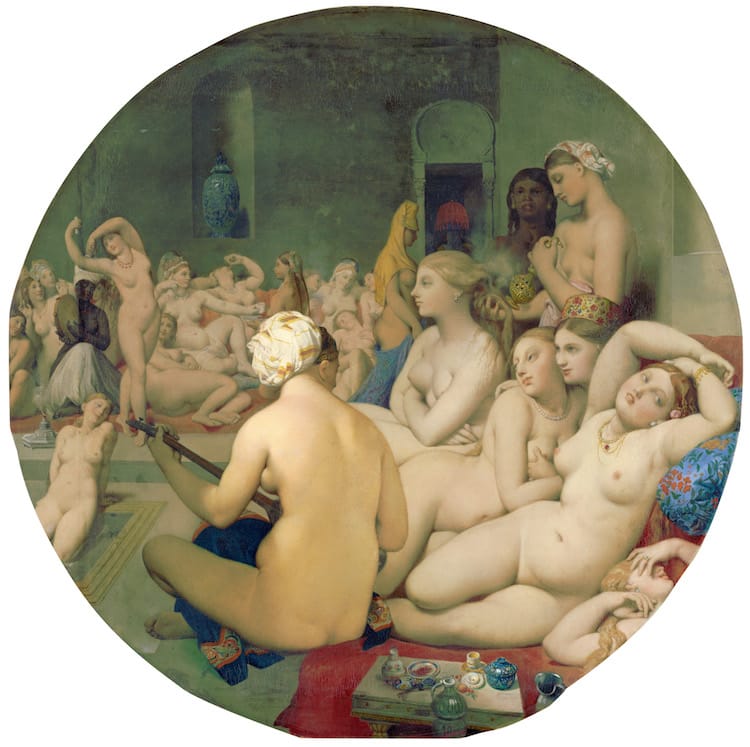
Jean-Auguste-Dominique Ingres, “The Turkish Bath,” 1862 (Photo: Wikimedia Commons, Public domain)
French artist Jean-August-Dominique Ingres was an upholder of the Neoclassical art style, even as Romanticism grew in popularity. As a master of draftsmanship, he created crisply-rendered paintings with smooth modeling and no visible brushstrokes. The Turkish Bath is part of his series of Orientalist paintings, portraying a harem of naked women lounging by the pool. It was completed when the artist was 83 years old.
Find out where more famous art is located in our guide.
Frequently Asked Questions
- How many paintings are in the Louvre?
The Louvre contains over 7,500 paintings, many of which are by French artists.
- What famous painting is found in the Louvre?
Leonardo da Vinci's Mona Lisa has become one of the most famous paintings in art history and is on display at the Louvre.
- Is Starry Night in the Louvre?
No. Vincent van Gogh's The Starry Night is in the Museum of Modern Art in New York City.
Related Articles:
5 Must-See Museums in Paris (That Aren’t The Louvre or Musée d’Orsay)
The Spectacular History of Mont-Saint-Michel, a Medieval Island Off the Coast of France
History of the Musée d’Orsay: From Parisian Train Station to World-Class Art Museum
Explore the Grandeur of Hadrian’s Villa, a Lavish Palace Fit for a Roman Emperor
READ: Discover 20 Famous Paintings All Located at Paris’ Iconic Louvre Museum
0 Commentaires